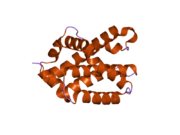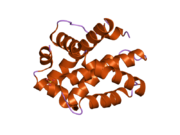Biology:Bcl-2 homologous antagonist killer
 Generic protein structure example |
Bcl-2 homologous antagonist/killer is a protein that in humans is encoded by the BAK1 gene on chromosome 6.[1][2] The protein encoded by this gene belongs to the BCL2 protein family. BCL2 family members form oligomers or heterodimers and act as anti- or pro-apoptotic regulators that are involved in a wide variety of cellular activities. This protein localizes to mitochondria, and functions to induce apoptosis. It interacts with and accelerates the opening of the mitochondrial voltage-dependent anion channel, which leads to a loss in membrane potential and the release of cytochrome c. This protein also interacts with the tumor suppressor P53 after exposure to cell stress.[3]
Structure
BAK1 is a pro-apoptotic Bcl-2 protein containing four Bcl-2 homology (BH) domains: BH1, BH2, BH3, and BH4. These domains are composed of nine α-helices, with a hydrophobic α-helix core surrounded by amphipathic helices and a transmembrane C-terminal α-helix anchored to the mitochondrial outer membrane (MOM). A hydrophobic groove formed along the C-terminal of α2 to the N-terminal of α5, and some residues from α8, binds the BH3 domain of other BCL-2 proteins in its active form.[4]
Function
As a member of the BCL2 protein family, BAK1 functions as a pro-apoptotic regulator involved in a wide variety of cellular activities.[3] In healthy mammalian cells, BAK1 localizes primarily to the MOM, but remains in an inactive form until stimulated by apoptotic signaling. The inactive form of BAK1 is maintained by the protein’s interactions with VDAC2, Mtx2, and other anti-apoptotic members of the BCL2 protein family. Nonetheless, VDAC2 functions to recruit newly synthesized BAK1 to the mitochondria to carry out apoptosis.[5] Moreover, BAK1 is believed to induce the opening of the mitochondrial voltage-dependent anion channel, leading to release of cytochrome c from the mitochondria.[3] Alternatively, BAK1 itself forms an oligomeric pore, MAC, in the MOM, through which pro-apoptotic factors leak in a process called MOM permeabilization.[6][7][8]
Clinical significance
Generally, the pro-apoptotic function of BAK1 contributes to neurodegenerative and autoimmune diseases when overexpressed and cancers when inhibited.[5] For instance, dysregulation of the BAK gene has been implicated in human gastrointestinal cancers, indicating that the gene plays a part in the pathogenesis of some cancers.[9][10]
BAK1 is also involved in the HIV replication pathway, as the virus induces apoptosis in T cells via Casp8p41, which activates BAK to carry out membrane permeabilization, leading to cell death.[11] Consequently, drugs that regulate BAK1 activity present promising treatments for these diseases.[4]
Recently, one study of the role of genetics in abdominal aortic aneurysm (AAA) showed that different BAK1 variants can exist in both diseased and non-diseased AA tissues compared to matching blood samples.[12][13] Given the current paradigm that all cells have the same genomic DNA, BAK1 gene variants in different tissues may be easily explained by the expression of BAK1 gene on chromosome 6 and one its edited copies on chromosome 20.[14]
Interactions
BAK1 has been shown to interact with:
- BCL2-like 1,[15][16][17][18][19]
- Bcl-2,[20][21]
- MCL1,[18][22][23][24]
- P53,[22]
- Casp8p41,[11]
- VDAC2,[5]
- Mtx2,[5]
- Mcl-1,[5]
- Bid,[7]
- Bim,[7] and
- Puma.[7]
References
- ↑ "Induction of apoptosis by the Bcl-2 homologue Bak". Nature 374 (6524): 733–6. April 1995. doi:10.1038/374733a0. PMID 7715730. Bibcode: 1995Natur.374..733C.
- ↑ "Modulation of apoptosis by the widely distributed Bcl-2 homologue Bak". Nature 374 (6524): 736–9. April 1995. doi:10.1038/374736a0. PMID 7715731. Bibcode: 1995Natur.374..736K.
- ↑ 3.0 3.1 3.2 "Entrez Gene: BAK1 BCL2-antagonist/killer 1". https://www.ncbi.nlm.nih.gov/sites/entrez?Db=gene&Cmd=ShowDetailView&TermToSearch=578.
- ↑ 4.0 4.1 "Building blocks of the apoptotic pore: how Bax and Bak are activated and oligomerize during apoptosis". Cell Death and Differentiation 21 (2): 196–205. February 2014. doi:10.1038/cdd.2013.139. PMID 24162660.
- ↑ 5.0 5.1 5.2 5.3 5.4 "Metaxins 1 and 2, two proteins of the mitochondrial protein sorting and assembly machinery, are essential for Bak activation during TNF alpha triggered apoptosis". Cellular Signalling 26 (9): 1928–34. September 2014. doi:10.1016/j.cellsig.2014.04.021. PMID 24794530.
- ↑ "Deficiency in apoptotic effectors Bax and Bak reveals an autophagic cell death pathway initiated by photodamage to the endoplasmic reticulum". Autophagy 2 (3): 238–40. 2006. doi:10.4161/auto.2730. PMID 16874066.
- ↑ 7.0 7.1 7.2 7.3 "Bioactive lipids and the control of Bax pro-apoptotic activity". Cell Death & Disease 5 (5): e1266. May 2014. doi:10.1038/cddis.2014.226. PMID 24874738.
- ↑ "BAK/BAX macropores facilitate mitochondrial herniation and mtDNA efflux during apoptosis". Science 359 (6378): eaao6047. February 2018. doi:10.1126/science.aao6047. PMID 29472455.
- ↑ "BAK overexpression mediates p53-independent apoptosis inducing effects on human gastric cancer cells". BMC Cancer 4: 33. July 2004. doi:10.1186/1471-2407-4-33. PMID 15248898.
- ↑ "Suppression of apoptosis, crypt hyperplasia, and altered differentiation in the colonic epithelia of bak-null mice". Gastroenterology 136 (3): 943–52. March 2009. doi:10.1053/j.gastro.2008.11.036. PMID 19185578.
- ↑ 11.0 11.1 "Casp8p41 generated by HIV protease kills CD4 T cells through direct Bak activation". The Journal of Cell Biology 206 (7): 867–76. September 2014. doi:10.1083/jcb.201405051. PMID 25246614.
- ↑ Michel Eduardo Beleza Yamagishi (2009). "A simpler explanation to BAK1 gene variation in Aortic and Blood tissues". arXiv:0909.2321 [q-bio.GN].
- ↑ "BAK1 gene variation and abdominal aortic aneurysms". Human Mutation 30 (7): 1043–7. July 2009. doi:10.1002/humu.21046. PMID 19514060.
- ↑ "BAK1 gene variation and abdominal aortic aneurysms-variants are likely due to sequencing of a processed gene on chromosome 20". Human Mutation 31 (1): 108–9; author reply 110–1. January 2010. doi:10.1002/humu.21147. PMID 19847788.
- ↑ "Towards a proteome-scale map of the human protein-protein interaction network". Nature 437 (7062): 1173–8. October 2005. doi:10.1038/nature04209. PMID 16189514. Bibcode: 2005Natur.437.1173R.
- ↑ "Development of a high-throughput fluorescence polarization assay for Bcl-x(L)". Analytical Biochemistry 307 (1): 70–5. August 2002. doi:10.1016/s0003-2697(02)00028-3. PMID 12137781.
- ↑ "High-throughput methods to detect dimerization of Bcl-2 family proteins". Analytical Biochemistry 322 (2): 170–8. November 2003. doi:10.1016/j.ab.2003.07.014. PMID 14596824.
- ↑ 18.0 18.1 "Proapoptotic Bak is sequestered by Mcl-1 and Bcl-xL, but not Bcl-2, until displaced by BH3-only proteins". Genes & Development 19 (11): 1294–305. June 2005. doi:10.1101/gad.1304105. PMID 15901672.
- ↑ "Death by design: the big debut of small molecules". Nature Cell Biology 3 (2): E43–6. February 2001. doi:10.1038/35055145. PMID 11175758.
- ↑ "Conversion of Bcl-2 from protector to killer by interaction with nuclear orphan receptor Nur77/TR3". Cell 116 (4): 527–40. February 2004. doi:10.1016/s0092-8674(04)00162-x. PMID 14980220.
- ↑ "Discovery of small-molecule inhibitors of Bcl-2 through structure-based computer screening". Journal of Medicinal Chemistry 44 (25): 4313–24. December 2001. doi:10.1021/jm010016f. PMID 11728179.
- ↑ 22.0 22.1 "Fatal liaisons of p53 with Bax and Bak". Nature Cell Biology 6 (5): 386–8. May 2004. doi:10.1038/ncb0504-386. PMID 15122264.
- ↑ "Specific cleavage of Mcl-1 by caspase-3 in tumor necrosis factor-related apoptosis-inducing ligand (TRAIL)-induced apoptosis in Jurkat leukemia T cells". The Journal of Biological Chemistry 280 (11): 10491–500. March 2005. doi:10.1074/jbc.M412819200. PMID 15637055.
- ↑ "MCL-1S, a splicing variant of the antiapoptotic BCL-2 family member MCL-1, encodes a proapoptotic protein possessing only the BH3 domain". The Journal of Biological Chemistry 275 (33): 25255–61. August 2000. doi:10.1074/jbc.M909826199. PMID 10837489.
Further reading
- "Deficiency in apoptotic effectors Bax and Bak reveals an autophagic cell death pathway initiated by photodamage to the endoplasmic reticulum". Autophagy 2 (3): 238–40. 2007. doi:10.4161/auto.2730. PMID 16874066.
- "Cloning of a bcl-2 homologue by interaction with adenovirus E1B 19K". Nature 374 (6524): 731–3. April 1995. doi:10.1038/374731a0. PMID 7715729. Bibcode: 1995Natur.374..731F.
- "A conserved domain in Bak, distinct from BH1 and BH2, mediates cell death and protein binding functions". The EMBO Journal 14 (22): 5589–96. November 1995. doi:10.1002/j.1460-2075.1995.tb00246.x. PMID 8521816.
- "Structure of Bcl-xL-Bak peptide complex: recognition between regulators of apoptosis". Science 275 (5302): 983–6. February 1997. doi:10.1126/science.275.5302.983. PMID 9020082.
- "A common binding site mediates heterodimerization and homodimerization of Bcl-2 family members". The Journal of Biological Chemistry 272 (17): 11350–5. April 1997. doi:10.1074/jbc.272.17.11350. PMID 9111042.
- "The conserved N-terminal BH4 domain of Bcl-2 homologues is essential for inhibition of apoptosis and interaction with CED-4". The EMBO Journal 17 (4): 1029–39. February 1998. doi:10.1093/emboj/17.4.1029. PMID 9463381.
- "Genomic structure and domain organisation of the human Bak gene". Gene 211 (1): 87–94. April 1998. doi:10.1016/S0378-1119(98)00101-2. PMID 9573342.
- "Bax interacts with the permeability transition pore to induce permeability transition and cytochrome c release in isolated mitochondria". Proceedings of the National Academy of Sciences of the United States of America 95 (25): 14681–6. December 1998. doi:10.1073/pnas.95.25.14681. PMID 9843949. Bibcode: 1998PNAS...9514681N.
- "Boo, a novel negative regulator of cell death, interacts with Apaf-1". The EMBO Journal 18 (1): 167–78. January 1999. doi:10.1093/emboj/18.1.167. PMID 9878060.
- "Cell damage-induced conformational changes of the pro-apoptotic protein Bak in vivo precede the onset of apoptosis". The Journal of Cell Biology 144 (5): 903–14. March 1999. doi:10.1083/jcb.144.5.903. PMID 10085290.
- "Bcl-2 family proteins regulate the release of apoptogenic cytochrome c by the mitochondrial channel VDAC". Nature 399 (6735): 483–7. June 1999. doi:10.1038/20959. PMID 10365962. Bibcode: 1999Natur.399..483S.
- "A novel adenovirus E1B19K-binding protein B5 inhibits apoptosis induced by Nip3 by forming a heterodimer through the C-terminal hydrophobic region". Cell Death and Differentiation 6 (4): 314–25. April 1999. doi:10.1038/sj.cdd.4400493. PMID 10381623.
- "Survival activity of Bcl-2 homologs Bcl-w and A1 only partially correlates with their ability to bind pro-apoptotic family members". Cell Death and Differentiation 6 (6): 525–32. June 1999. doi:10.1038/sj.cdd.4400519. PMID 10381646.
- "Characterization of the antiapoptotic Bcl-2 family member myeloid cell leukemia-1 (Mcl-1) and the stimulation of its message by gonadotropins in the rat ovary". Endocrinology 140 (12): 5469–77. December 1999. doi:10.1210/endo.140.12.7171. PMID 10579309.
- "Proapoptotic BH3-only Bcl-2 family members induce cytochrome c release, but not mitochondrial membrane potential loss, and do not directly modulate voltage-dependent anion channel activity". Proceedings of the National Academy of Sciences of the United States of America 97 (2): 577–82. January 2000. doi:10.1073/pnas.97.2.577. PMID 10639121. Bibcode: 2000PNAS...97..577S.
- "MCL-1S, a splicing variant of the antiapoptotic BCL-2 family member MCL-1, encodes a proapoptotic protein possessing only the BH3 domain". The Journal of Biological Chemistry 275 (33): 25255–61. August 2000. doi:10.1074/jbc.M909826199. PMID 10837489.
- "tBID, a membrane-targeted death ligand, oligomerizes BAK to release cytochrome c". Genes & Development 14 (16): 2060–71. August 2000. doi:10.1101/gad.14.16.2060. PMID 10950869.
- "Identification of small-molecule inhibitors of interaction between the BH3 domain and Bcl-xL". Nature Cell Biology 3 (2): 173–82. February 2001. doi:10.1038/35055085. PMID 11175750.
- "Suppression of apoptosis, crypt hyperplasia, and altered differentiation in the colonic epithelia of bak-null mice". Gastroenterology 136 (3): 943–52. March 2009. doi:10.1053/j.gastro.2008.11.036. PMID 19185578. http://www.gastrojournal.org/article/S0016-5085(08)02050-7/abstract?referrer=http%3A%2F%2Fwww.ncbi.nlm.nih.gov%2Fpubmed%2F19185578.
External links
- Human BAK1 genome location and BAK1 gene details page in the UCSC Genome Browser.
 |




